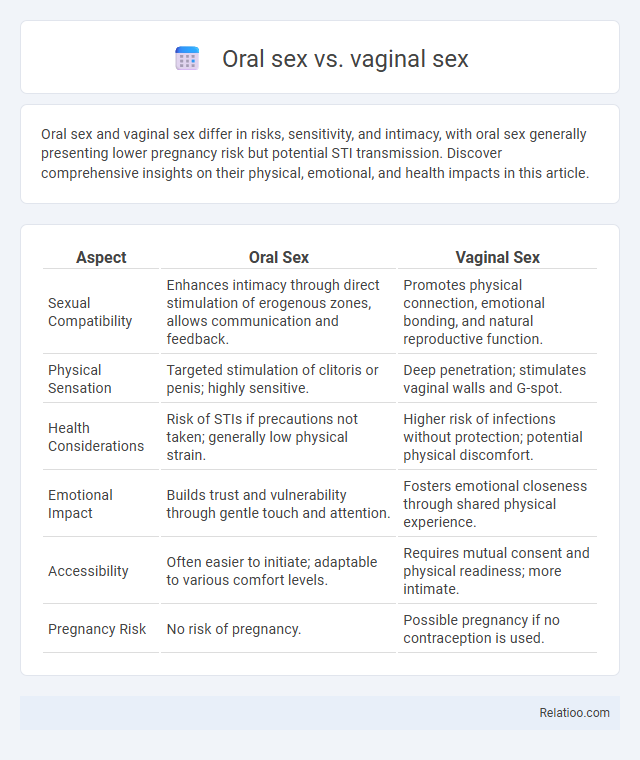Oral sex and vaginal sex differ in risks, sensitivity, and intimacy, with oral sex generally presenting lower pregnancy risk but potential STI transmission. Discover comprehensive insights on their physical, emotional, and health impacts in this article.
Table of Comparison
| Aspect | Oral Sex | Vaginal Sex |
|---|---|---|
| Sexual Compatibility | Enhances intimacy through direct stimulation of erogenous zones, allows communication and feedback. | Promotes physical connection, emotional bonding, and natural reproductive function. |
| Physical Sensation | Targeted stimulation of clitoris or penis; highly sensitive. | Deep penetration; stimulates vaginal walls and G-spot. |
| Health Considerations | Risk of STIs if precautions not taken; generally low physical strain. | Higher risk of infections without protection; potential physical discomfort. |
| Emotional Impact | Builds trust and vulnerability through gentle touch and attention. | Fosters emotional closeness through shared physical experience. |
| Accessibility | Often easier to initiate; adaptable to various comfort levels. | Requires mutual consent and physical readiness; more intimate. |
| Pregnancy Risk | No risk of pregnancy. | Possible pregnancy if no contraception is used. |
Introduction to Oral Sex vs Vaginal Sex
Oral sex and vaginal sex differ significantly in terms of physical stimulation and pleasure sensations, with oral sex often providing more direct clitoral or penile stimulation that can enhance sexual satisfaction. Vaginal sex involves penetration that stimulates the internal erogenous zones such as the G-spot, contributing to a distinct type of pleasure often associated with deeper intimacy. Understanding these differences helps individuals and couples explore varied sexual experiences and preferences for heightened pleasure and connection.
Defining Oral Sex and Vaginal Sex
Oral sex involves stimulating the partner's genitals with the mouth, lips, or tongue, targeting sensitive areas for enhanced pleasure. Vaginal sex refers to the penetration of the vagina by the penis, often associated with reproductive purposes and intimate connection. Your understanding of these distinct sexual practices can enhance communication and mutual satisfaction in intimate relationships.
Physical Pleasure: Comparison of Sensations
Oral sex often provides heightened physical pleasure due to direct stimulation of sensitive nerve endings, resulting in intensely varied sensations. Vaginal sex delivers deep, rhythmic sensations that activate internal pressure points, contributing to a different type of pleasure centered on fullness and movement. Understanding your body's unique responses to these forms can greatly enhance sexual satisfaction and overall experience.
Health Benefits and Risks
Oral sex offers lower risks of pregnancy and some sexually transmitted infections (STIs) compared to vaginal sex but can still transmit infections like herpes, gonorrhea, and HPV, impacting your oral and overall health. Vaginal sex carries a higher risk of pregnancy and STIs such as HIV, chlamydia, and trichomoniasis but also contributes to vaginal lubrication and pelvic floor strength, enhancing reproductive health. Both activities can boost pleasure and intimacy, promoting mental well-being, but practicing safe sex, including using barriers and regular testing, is essential for minimizing health risks.
STI Transmission and Protection
Oral sex and vaginal sex pose differing risks for STI transmission, with vaginal sex generally carrying a higher risk for infections like HIV, chlamydia, and gonorrhea, while oral sex can transmit herpes, gonorrhea, and syphilis more commonly. Consistent use of condoms or dental dams significantly reduces STI transmission during both oral and vaginal sex, serving as an effective barrier. Regular testing, vaccination for preventable diseases like HPV and hepatitis B, and open communication with partners are essential components of sexual health and STI prevention.
Emotional and Psychological Impact
Oral sex and vaginal sex each evoke distinct emotional and psychological responses that influence your overall sexual satisfaction and intimacy. Oral sex often fosters heightened feelings of trust, vulnerability, and connection due to its intimate nature, while vaginal sex can deepen emotional bonds through physical closeness and hormonal release. Both acts contribute differently to pleasure and emotional well-being, making understanding their unique impacts essential for enhancing relationship intimacy and personal fulfillment.
Impact on Relationships and Communication
Oral sex and vaginal sex each influence relationships and communication differently, with oral sex often fostering increased intimacy and trust through enhanced verbal and nonverbal cues. Vaginal sex typically serves as a primary physical connection that reinforces emotional bonds and deepens mutual understanding. Your ability to openly discuss preferences and boundaries in both acts strengthens relationship satisfaction and emotional closeness.
Cultural and Social Perspectives
Oral sex and vaginal sex hold varied cultural and social meanings that influence perceptions of pleasure and acceptability across societies. Many cultures associate vaginal sex primarily with reproduction and marital norms, while oral sex often carries stigmatized or taboo connotations despite its role in enhancing sexual pleasure. Social attitudes towards these practices shape individual experiences of intimacy and can affect communication about sexual satisfaction and consent within different cultural contexts.
Consent and Boundaries
Consent and clear communication are essential for both oral and vaginal sex to ensure mutual pleasure and respect for personal boundaries. Understanding and respecting Your partner's comfort levels creates a safe environment where both parties can enjoy intimacy without pressure or discomfort. Establishing boundaries beforehand fosters trust and enhances the overall sexual experience.
Safe Sex Practices and Tips
Oral sex and vaginal sex both carry risks of sexually transmitted infections (STIs), so using barrier methods like condoms or dental dams is essential for safe sex practices. Maintaining open communication with your partner about sexual health status and regularly getting tested can significantly reduce your risk of infections. Your pleasure remains a priority, and combining safety measures with mutual consent enhances the overall experience while protecting your well-being.

Infographic: Oral sex vs Vaginal sex
 relatioo.com
relatioo.com